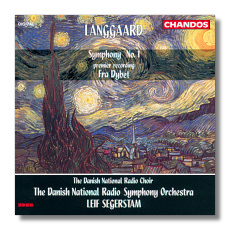
The Internet's Premier Classical Music Source
Related Links
- Latest Reviews
- More Reviews
-
By Composer
-
Collections
DVD & Blu-ray
Books
Concert Reviews
Articles/Interviews
Software
Audio
Search Amazon
Recommended Links
Site News
 CD Review
CD Review
Rued Langgaard

- Symphony #1 "Rock Pastorals" (Klippepastoraler) (1911)
- Fra Dybet
Danish National Radio Symphony and Choir/Leif Segerstam
Chandos CHAN9249 DDD 76:08
The life and works of the Danish composer Rued Langgaard (1893-1952) present one of the odder stories in the annals of classical music. He was a child prodigy of enormous talent who grew into a man of breathtaking fecundity. His music was largely ignored by his contemporaries and was left in a state of near-chaos by the composer himself, as he kept returning to his music, revising and recycling it. The music itself varies from the self-indulgently banal at the bottom end of the scale to the blazingly original and powerful at the top. You'll find the best brief overview of this strange and fascinating figure among the back numbers of CD Review, in Calum MacDonald's survey-review in the May 1993 issue, written when Danacord released its complete set of the Langgaard Symphonies.
The five-movement First Symphony, subtitled 'Klippepastoraler' ('Pastorals of the Rocks'), must be one of the most ambitious first symphonies ever attempted – and it's certainly the most ambitious ever tackled by a fourteen-year-old: it weighs in (in this recording) at not much short of seventy minutes, the first movement alone making a gargantuan 23:06. It was begun in the spring of 1908, finished the next year, and underwent a series of revisions until 1911, when Langgaard was all of seventeen. It was premièred two years later, by Max Fiedler and the Berlin Philharmonic Orchestra – an auspicious start to a career that soon ran aground.
Laggaard's style is late-Romantic writ large, consistently epic and extravagant, overscored – sometimes wonderfully so, with occasional echoes of, among others, Wagner, Tchaikovsky, Bruckner, Elgar (whom he had probably never heard at the time), and Nielsen (particularly his First Symphony in Langgaard's slow movement – though Langgaard would hated that observation: he was convinced that Nielsen and his circle were out to suppress his music, and wrote a cantata, Carl Nielsen, vor store mester (Carl Nielsen, Our Great Master), with a suitably sarcastic text). The music is full of grandiose orchestral gestures, some of which are very effective, and glorious tunes, some of which do exactly what you want them to; and it has its structural weaknesses, as you'd expect of a composer of such little experience – the coda of the first movement, for example, seems interminable. Indeed, the music as a whole seems to go on and on, only just earning the listener's patience by its patent sincerity. This performance is, moreover, twelve minutes longer (and much better played) than Ilya Stupel's on Danacord (DACOCD 404), but Segerstam gives the bloated score so much more shape, and finds so much more substance in it, that there is no competition. Segerstam seems to have said to himself that there is no point in apologising for the work, and he gives it for all it is worth. At times the result is electrifying.
The final nail in Stupel's coffin is Segerstam's inclusion of Fra Dypet (From the Deep), since Danacord offers no filler. It's an extraordinary piece, composed shortly before Langgaard's death in 1952 – and thus revealing that his gargantuanism was with him till the end. It begins with an orchestral funeral march which is interrupted by an organ playing a chorale, which is in turn superseded by a chorus singing a rather Berliozian setting of the Requiem. Decidedly odd, but stuffed full of rich, even over-ripe, music again redeemed by its unarguable sincerity.
Add notes by Bendt Viinholt Nielsen (the scholar who managed to impose order on Langgaard's unruly catalogue) and a meaty, full-bodied orchestral sound, and this second Chandos excursion into the Langgaard Symphonies (Järvi conducts #4, 5 and 6 on CHAN9064) is an undoubted success – admittedly an uneven one, but a winner nonetheless.
Copyright © 1994 & 1998, Martin Anderson.
This review originally appeared in CD Review


















